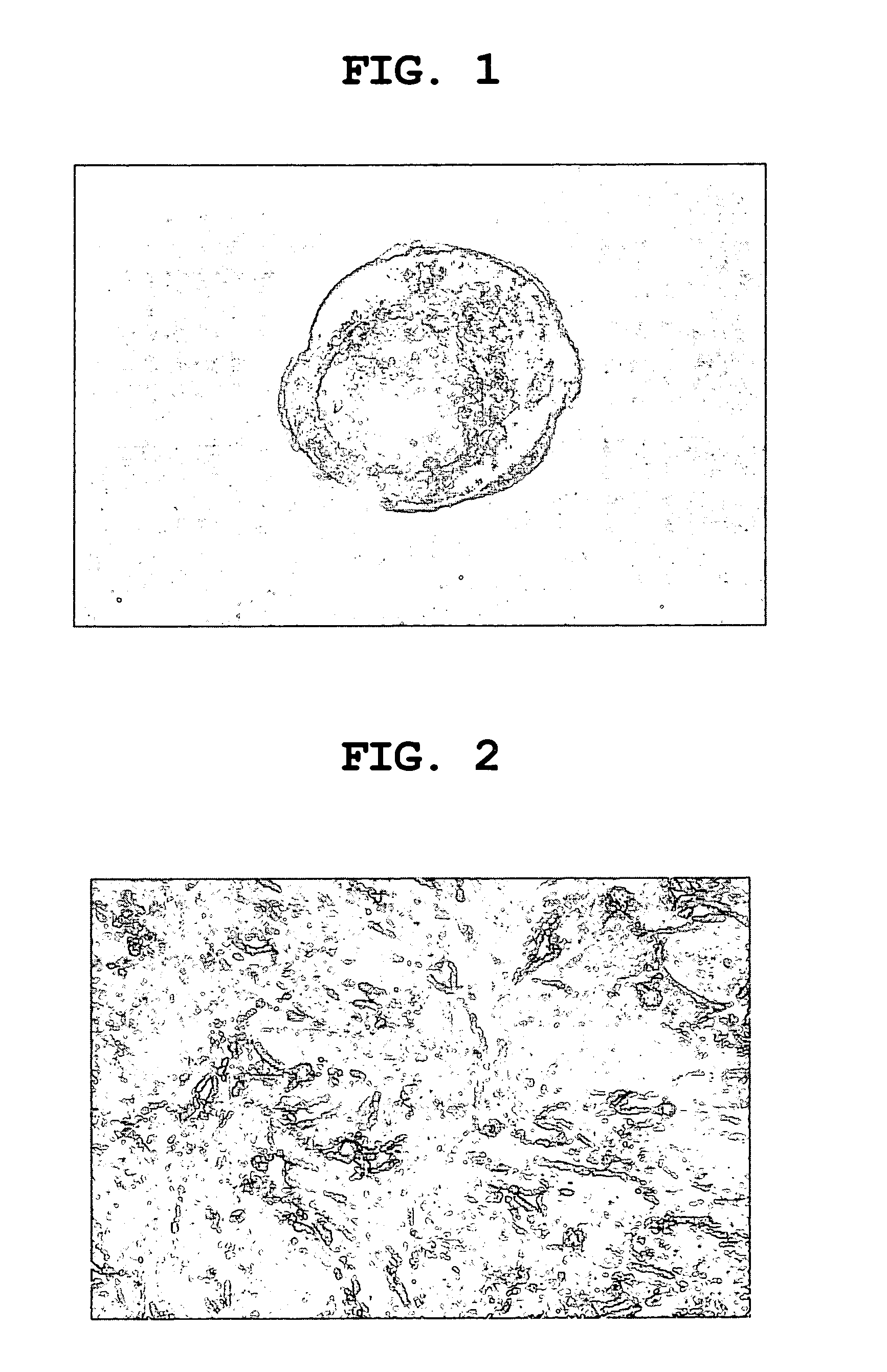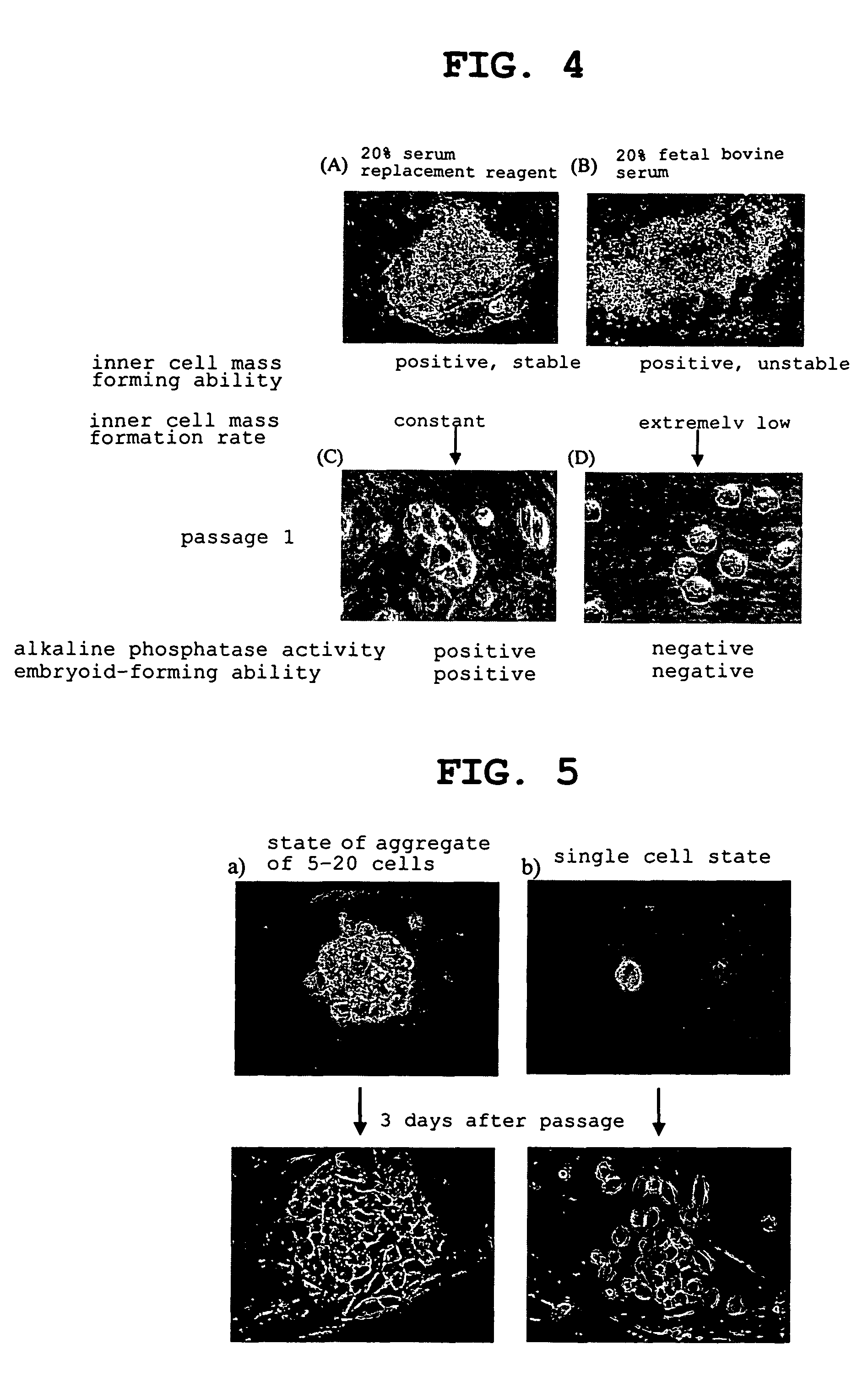Rat embryonic stem cell
a technology rat embryos, which is applied in the field of embryonic stem cells of rat embryos, can solve the problems of insufficient establishment of rat es cells essential for the production of genetically modified rat, failure chimeric cells, and inability to establish rat es cells
- Summary
- Abstract
- Description
- Claims
- Application Information
AI Technical Summary
Benefits of technology
Problems solved by technology
Method used
Image
Examples
example 1
Establishment of Rat ES Cell
1) Oocyte Sampling
[0246]A female WKY / N (Wistar Kyoto strain, Charles River Laboratories Japan, 10-week-old or older) was naturally crossbred, at 3 days after vaginal plug confirmation, the female rat for oocyte sampling was sacrificed and the uterus was excised. After perfusing with mw medium (640.0 mg / 100 ml, NaCl, 35.6 mg / 100 ml KCl, 16.2 mg / 100 ml KH2PO4, 29.4 mg / 100 ml MgSO4-7H2O, 190.0 mg / 100 ml NaHCO3, 100.0 mg / 100 ml Glucose, 2.5 mg / 100 ml Na-pyruvate, 46.0 mg / 100 ml Ca-lactate, 5.0 mg / 100 ml Streptomycin, 7.5 mg / 100 ml Penicillin, 0.5% phenrol red (0.2 ml), 20 mM beta-ME (10 μl), 100 mM EDTA-2Na (10 μl), 300.0 mg / 100 ml BSA), the embryo was recovered, and developed to become blastocyst (late stage) in 5% CO2 incubator (FIG. 1). In the establishment of rat ES cell, since oocytes in the late stage of blastocyst showed the highest establishment (inner cell mass formation) efficiency, the oocyte in the late stage of blastocyst was used as shown above....
example 2
Analysis of Established Rat ES Cell
[0279]Using rat ES cells of passage 5, the presence of the property as ES cell was confirmed. To be specific, each of the following properties was examined.
1) Analysis of Expression of Marker Gene for Undifferentiated State by RT-PCR Analysis
[0280]The presence or absence of expression of Oct3 / 4 and Nanog 10 genes, which are representative markers for undifferentiated state, in the established rat ES cells was confirmed. First of all, total RNA was extracted from the established rat ES cells using ISOGEN (Nippon Gene, Tokyo, Japan). The single strand cDNA was synthesized in a mixture (total amount of 20 μl) including total RNA 2 μg, oligo(dT)18 primers 0.5 μl, dNTPs 10 pmol, RAV-2 RTase 5 units, and single strand synthesis buffer (Takara, Kyoto, Japan). Synthesis was performed at 37° C. for 10 min, 42° C. for 1 hr, 56° C. for 10 min, and 99° C. for 5 min In addition, the following primers were synthesized (the oligonucleotide sequences are described...
example 3
Establishment of ES Cell and Analysis of Established Rat ES Cell (2)
1) Establishment of ES Cell
[0297]In the same manner as in the case of Wistar Kyoto rat (WKY) shown in Example 1, ES cell was also established in Wistar Hannover GALAS rat (WHG) and Brown Norway rat (BN). As a result, ES cells of both rats could be established. The photographs of the inner cell masses formed from the blastocysts of respective rats (WKY, WHG and BN) are shown in FIG. 20. The photographs of the established ES cells (passage 5) are also shown in FIG. 20. It was confirmed that, in both the WHG rat ES cell and BN rat ES cell, subculture while holding the undifferentiated state-maintaining ability as in WKY rat ES cell was possible.
2) Analysis of Expression of ES Cell Marker Genes by RT-PCR Analysis
[0298]The presence or absence of the expression of ES cell marker genes in the established WKY rat ES cell, WHG rat ES cell and BN rat ES cell was confirmed by RT-PCR analysis. The experiment was performed in th...
PUM
| Property | Measurement | Unit |
|---|---|---|
| size | aaaaa | aaaaa |
| temperature | aaaaa | aaaaa |
| temperature | aaaaa | aaaaa |
Abstract
Description
Claims
Application Information
 Login to View More
Login to View More - R&D
- Intellectual Property
- Life Sciences
- Materials
- Tech Scout
- Unparalleled Data Quality
- Higher Quality Content
- 60% Fewer Hallucinations
Browse by: Latest US Patents, China's latest patents, Technical Efficacy Thesaurus, Application Domain, Technology Topic, Popular Technical Reports.
© 2025 PatSnap. All rights reserved.Legal|Privacy policy|Modern Slavery Act Transparency Statement|Sitemap|About US| Contact US: help@patsnap.com



